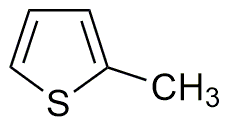2-Methylthiophene is widely utilized in research focused on various practical applications:
- Flavor and Fragrance Industry: This compound is used as a flavoring agent in food products and as a fragrance component in perfumes, providing a unique and appealing scent profile.
- Organic Synthesis: It serves as an important building block in organic chemistry, facilitating the synthesis of more complex molecules, which is crucial for pharmaceutical development.
- Petrochemical Industry: 2-Methylthiophene is employed in the production of specialty chemicals, enhancing the performance of fuels and lubricants by improving their stability and efficiency.
- Research in Material Science: The compound is investigated for its potential use in developing new materials, such as conductive polymers, which can be used in electronics and coatings.
- Environmental Applications: It is studied for its role in the degradation of pollutants, offering potential solutions for environmental remediation efforts.
General Information
Properties
Safety and Regulations
Applications
2-Methylthiophene is widely utilized in research focused on various practical applications:
- Flavor and Fragrance Industry: This compound is used as a flavoring agent in food products and as a fragrance component in perfumes, providing a unique and appealing scent profile.
- Organic Synthesis: It serves as an important building block in organic chemistry, facilitating the synthesis of more complex molecules, which is crucial for pharmaceutical development.
- Petrochemical Industry: 2-Methylthiophene is employed in the production of specialty chemicals, enhancing the performance of fuels and lubricants by improving their stability and efficiency.
- Research in Material Science: The compound is investigated for its potential use in developing new materials, such as conductive polymers, which can be used in electronics and coatings.
- Environmental Applications: It is studied for its role in the degradation of pollutants, offering potential solutions for environmental remediation efforts.
Documents
Safety Data Sheets (SDS)
The SDS provides comprehensive safety information on handling, storage, and disposal of the product.
Product Specification (PS)
The PS provides a comprehensive breakdown of the product’s properties, including chemical composition, physical state, purity, and storage requirements. It also details acceptable quality ranges and the product's intended applications.
Certificates of Analysis (COA)
Search for Certificates of Analysis (COA) by entering the products Lot Number. Lot and Batch Numbers can be found on a product’s label following the words ‘Lot’ or ‘Batch’.
*Catalog Number
*Lot Number
Certificates Of Origin (COO)
This COO confirms the country where the product was manufactured, and also details the materials and components used in it and whether it is derived from natural, synthetic, or other specific sources. This certificate may be required for customs, trade, and regulatory compliance.
*Catalog Number
*Lot Number
Safety Data Sheets (SDS)
The SDS provides comprehensive safety information on handling, storage, and disposal of the product.
DownloadProduct Specification (PS)
The PS provides a comprehensive breakdown of the product’s properties, including chemical composition, physical state, purity, and storage requirements. It also details acceptable quality ranges and the product's intended applications.
DownloadCertificates of Analysis (COA)
Search for Certificates of Analysis (COA) by entering the products Lot Number. Lot and Batch Numbers can be found on a product’s label following the words ‘Lot’ or ‘Batch’.
*Catalog Number
*Lot Number
Certificates Of Origin (COO)
This COO confirms the country where the product was manufactured, and also details the materials and components used in it and whether it is derived from natural, synthetic, or other specific sources. This certificate may be required for customs, trade, and regulatory compliance.


